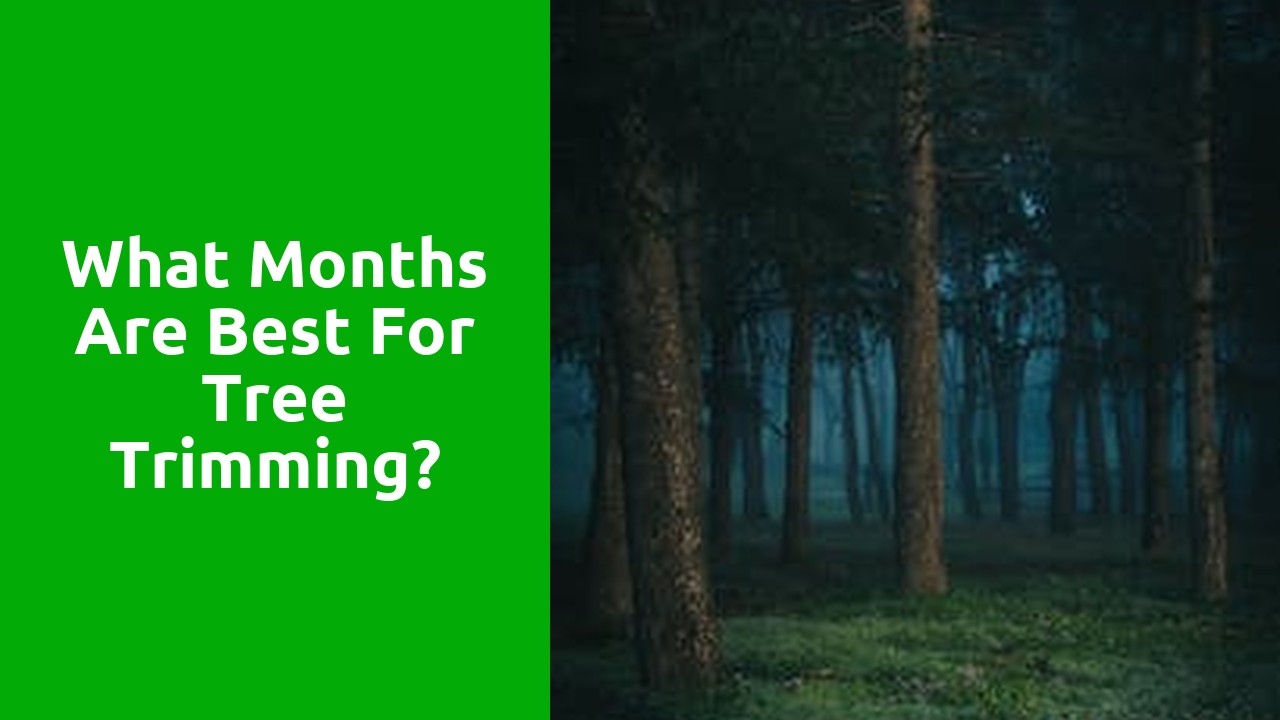What months are best for tree trimming?

Why is Tree Trimming Important?
Tree trimming plays a vital role in maintaining the overall health and safety of trees. By removing dead or diseased branches, you prevent the spread of infection to other parts of the tree, ensuring its longevity. Trimming also helps to improve the tree's aesthetics, making it more visually appealing. Furthermore, properly pruned trees are less likely to become a hazard during storms or high winds, reducing the risk of falling branches and potential property damage.
Apart from health and safety concerns, tree trimming is essential for maintaining the surrounding environment. By removing excessive foliage, sunlight is able to penetrate through the branches, reaching the ground beneath. This not only benefits the tree itself but also allows other vegetation to thrive. Additionally, trimming enables better air circulation within the tree, reducing the risk of fungal infections and promoting healthy growth. Thus, tree trimming not only benefits the individual tree but also enhances the overall ecological balance.
Factors to Consider Before Tree Trimming
Before proceeding with tree trimming, there are several important factors that should be carefully considered. Firstly, it is crucial to determine the reason behind the trimming. Are you looking to enhance the tree's overall appearance or structure? Is there a safety concern due to overgrown branches? Understanding the purpose will help guide the trimming process and ensure the desired outcome is achieved.
Secondly, the type and size of the tree must be taken into account. Different tree species may have specific growth patterns and requirements when it comes to trimming. Moreover, the size of the tree can affect the complexity and safety precautions needed during the trimming process. Assessing these factors will allow you to adopt the most appropriate pruning techniques and ensure the health of the tree is not compromised.
Understanding the Dormant Season for Tree Trimming
During the dormant season, trees undergo a period of rest and inactivity. This is typically the winter months when the temperatures drop, and the days become shorter. As the tree's growth slows down, it enters a dormant state to conserve energy and protect itself from harsh weather conditions. This dormant season is an ideal time for tree trimming and pruning.
One of the main advantages of trimming trees during the dormant season is the reduced risk of disease transmission. Insects and fungi that spread diseases are less active during this time, reducing the chances of infections in the freshly pruned areas. Additionally, without leaves on the branches, it is easier for arborists to see the structure of the tree and identify any potential issues such as weak branches or excessive growth. Trimming during the dormant season also minimizes the impact on the tree since it is not actively growing, allowing it to heal more efficiently. So, by taking advantage of the tree's natural dormancy, homeowners and arborists can promote healthy growth and maintain the overall well-being of the trees on their property.
The Benefits of Trimming Trees in Winter
When it comes to tree care, trimming them in winter can offer a range of benefits. Firstly, winter is a time when trees are dormant, meaning they are not actively growing. This makes it the ideal time to prune them without causing any harm or stress. By removing dead or diseased branches, as well as shaping the tree's overall structure, winter pruning promotes increased airflow and sunlight penetration. As a result, it helps to reduce the risk of diseases and pests, while also improving the tree's overall health and vitality.
In addition to promoting tree health, winter trimming also helps in maintaining the aesthetic appeal of trees. Without the leaves obscuring the branches, it becomes easier to assess the tree's structure and spot any irregularities or imbalances. By addressing these issues during winter, homeowners and arborists can ensure that the tree becomes more symmetrical and visually pleasing for the upcoming spring and summer seasons. Moreover, by removing any weak or crossing branches, winter pruning helps to prevent damage caused by heavy snow, ice, or strong winds, further preserving the tree's beauty and structural integrity.
The Advantages of Trimming Trees in Spring
Maintaining the health and appearance of trees is an ongoing effort that requires proper care and attention. As the spring season approaches, one of the most beneficial actions to take is trimming trees. There are several advantages to trimming trees during this time of year.
First and foremost, trimming trees in spring promotes growth and vitality. By removing dead or damaged branches, it allows for new, healthier growth to take place. The tree's energy is focused on developing strong and vibrant branches and leaves, leading to an overall healthier and more robust appearance. Additionally, trimming during spring helps stimulate the tree's natural rejuvenation process, allowing it to successfully recover from winter dormancy and be prepared for the upcoming growing season. Evidently, trimming trees in spring offers numerous advantages that contribute to their long-term well-being.
Tree Trimming Considerations for Summer
For many homeowners, summer is a time of enjoying the outdoors and tending to their gardens. However, one task that often goes overlooked is tree trimming. Whether you have a small backyard with a few trees or a larger property with a dense canopy, trimming your trees during the summer can have several benefits.
Firstly, summer is the ideal time to address any potential hazards caused by overgrown or weak branches. As trees grow, their branches can become heavy and prone to breakage, especially during storms or high winds. By trimming these branches in the summer, you can reduce the risk of damage to your property or injury to yourself or others. Additionally, removing dead or diseased branches can improve the overall health and appearance of your trees, promoting better growth and development.
Related Links
What is the difference between tree trim and tree prune?Do you need council approval to cut down a tree in NSW?